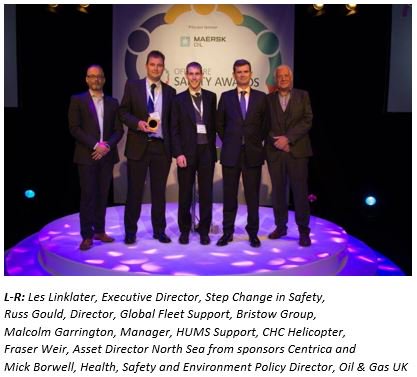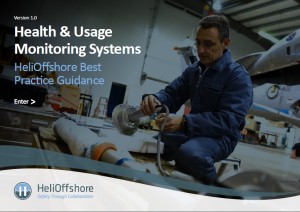HeliOffshore HUMS Best Practice Guide Wins Safety Award
Against stiff competition the HeliOffshore team who produced a Health & Usage Monitoring System (HUMS) Best Practice Guide have won the Award for Sharing and Learning at the Offshore Safety Awards 2016. That award, sponsored by Centrica:
…recognises an individual/team or company that can demonstrate a learning and sharing culture either within their organisation, or who has made a significant contribution to health and safety through active participation in, or engagement with Oil & Gas UK or Step Change in Safety.
The offshore helicopter safety organisation launched their HUMS Best Practice Guide in November 2015 to standardise and improve HUMS use worldwide. The award organisers noted that the launch of the 41 page HUMS Best Practice Guide and the shorter Implementation Guide, are:
…the result of a highly engaged industry putting momentum behind actions that will make the greatest difference to safety and of the collaborative and global approach taken by the HUMS working group.
The team was lead by Russell Gould (Director, Global Fleet Support, Bristow Group) and Malcolm Garrington (Manager HUMS Support, CHC) who collected the prize. Video.

After the Awards, Alexander Burnett MSP, Shadow Energy Spokesman, lodged a motion in the Scottish Parliament congratulating everyone who took part in the Awards and welcoming “all of the people and businesses that are helping make a positive difference to safety in the North Sea.”
The guides were the result of more than 12 months of hard work and over twenty meetings between the HUMS specialists from CHC, Babcock, ERA, Bristow, PHI, Weststar, Cougar and Bell. They have been made freely available to all helicopter operators, irrespective of whether they are members of HeliOffshore.
UPDATE 24 September 2016: In CAP1386, the UK CAA’s second update to their CAP1145 report (discussed further here), the CAA state that they have (emphasis added):
…reviewed CAA guidance material (CAP 753) and have made amendments [note: yet to be published] to reflect the EASA Certification Memorandum CM-DASA-001, which clarifies the terminology and the alert generation systems to ensure consistency.
HeliOffshore… has produced a HUMS Best Practice Guide which draws upon the in-service experience of a number of experts and Helicopter Operators and should assist other countries in applying VHM. The material within this guide complements CAP 753.
UPDATE 20 October 2017: HeliOffshore updates HUMS Best Practice Guidelines with new annexes. One of the new annexes in Version 1.1 covers the S-92A TR Pitch Change Shaft.
A subgroup under the leadership of Jason Alamond, HUMS program manager with Era Helicopters, has produced an annex defining The Ideal HUM System.
Meanwhile, another subgroup has developed a framework of key performance indicators (KPIs)… laying the groundwork for operators to be able to share and benchmark HUMS data. The HUMS KPI subgroup was led by Andy Evans, a director with Aerossurance.
HUMS Background
We have previously discussed several HUMS / VHM (Vibration Health Monitoring) topics:
- Aerossurance Wins UK Military Aviation Authority (MAA) HUMS Maintenance Credit Contract
- European Aviation Safety Agency (EASA) HUMS Research Developments
- EASA & US Federal Aviation Administration (FAA) HUMS / VHM Developments
- HeliOffshore Launch HUMS Best Practice Guide
We have also covered the 2016 HeliOffshore Annual Conference: Offshore Helicopter Safety Performance
HUMS Training, Coaching and Improvement Support
Aerossurance Director Andy Evans is a former UK CAA former HUMS specialist, JAA Rotors and Transmission Specialist, Secretary of the Helicopter Health Monitoring Advisory Group (HHMAG) and line manager of HUMS at a major offshore helicopter operator. Aerossurance is an active member of HeliOffshore and we have undertaken a number of HUMS technology, regulatory and certification projects recently. We have also recently developed a HUMS improvement workshop for one overseas client, based on our proven experience with HUMS systems stretching back to 1997 (including the development and delivery of HUMS training for UK CAA as far back as 2000 and a popular course delivered as part of the Heli-Expo Educational Programme from 2005 onwards). Our improvement workshop approach applied our observations on the 70:20:10 model of learning.


Recent Comments